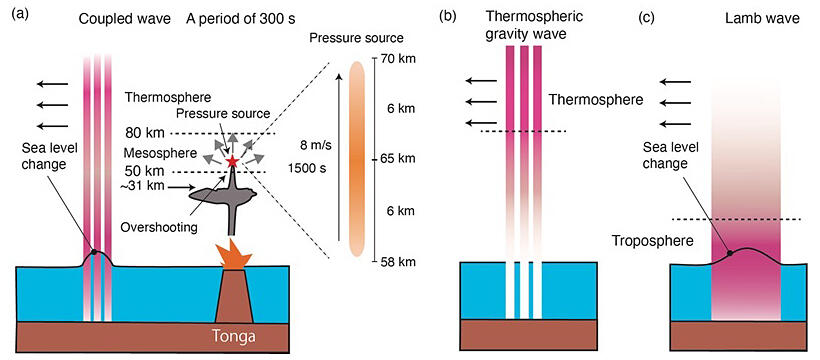Senior Researcher, Takashi Tonegawa of the Integrated Earthquake Observation and Research Group, the Subduction Dynamics Research Center (SDR), the Research Institute for Marine Geodynamics (IMG) at the Japan Agency for Marine-Earth Science and Technology (JAMSTEC) and his colleagues announced that they had discovered that the wave phenomena during the Hunga Tonga eruption in January last year included coupled waves, which are a combination of Lamb waves (with a duration of approximately 300 seconds) and thermospheric gravity waves. They investigated and analyzed water pressure gauges of the Seafloor observation network for earthquakes and tsunamis along the Japan Trench (S-net) and the Fundamental Volcano Observation Network (V-net) deployed by the National Research Institute for Earth Science and Disaster Resilience (NIED). It was found that the pressure epicenter that generated the Lamb waves reached the mesosphere at an altitude of 58−70 kilometers above the volcanic plume. This result is expected to lead to an improved prediction accuracy of meteorological tsunamis caused by far-reaching Lamb waves. The findings were published in the 28 June 2023 issue of the international journal Science Advances.

(a) Coupled waves at a period of ∼300 s propagate horizontally from the volcano, and their energies are distributed from the thermosphere to near ground surface. These waves induce sea level changes (air-sea coupled waves). The volcanic plume extends horizontally around an altitude of 30 km, and it reaches to an altitude of 57 km above the volcano, called overshooting. The pressure source is considered to reach to altitudes of 58−70 km. Because of the high altitude of the pressure source, the energy of the coupled waves in the thermosphere and mesosphere is larger than troposphere.
(b) Thermospheric gravity waves horizontally propagating along the thermosphere.
(c) Lamb waves horizontally propagating along near ground surface. Lamb waves induce sea level changes.
Provided by JAMSTEC
The Hunga Tonga eruption that occurred on January 15, 2022, in Tonga (located in the South Pacific) is considered the most massive natural event of the past century. Geostationary satellite records show that the volcanic plume rose to an altitude of 57 kilometers, and a cap cloud spread horizontally at an altitude of approximately 30 kilometers. The Lamb waves, which propagated horizontally along the surface of the Earth at a speed of 1,080 kilometers per hour, traveled to the far side of the Earth and caused a meteorological tsunami. However, the pressure epicenter (the cause of the atmospheric pressure change) that caused the Lamb waves was not well understood.
In this study, the researchers first analyzed S-net water pressure gauges deployed at 125 points in and around the Japan Trench and V-net barometers deployed in the Japanese islands. The barometers recorded changes in atmospheric pressure caused by the Lamb waves, and the water pressure gauges recorded meteorological tsunamis caused by the changes in atmospheric pressure.
When the spectrum of Lamb waves observed by the barometers was calculated, it was found that the Lamb wave has its maximum amplitude at a duration of approximately 1,700−2,500 seconds. Additionally, it was noticed that the amplitude becomes unusually large around the 300-second range, which corresponds to the short-duration component.
Regarding this approximately 300-second range, calculations were performed using the temperature profile of the atmosphere during the Hunga Tonga eruption to determine the types of wave fields and their propagation velocities in the atmosphere. As a result, two types of waves were discovered. One is the short-duration component of the Lamb waves near the water surface, and the other is the thermospheric gravity waves above the atmosphere. Both waves propagated at almost the same speed of approximately 300 meters per second with a duration of approximately 300 seconds. Researchers speculated that the combination and resonance of upper and lower waves would increase the amplitude and propagate horizontally.
To further clarify the altitude reached by the pressure epicenter, the researchers performed theoretical spectral calculations by varying the altitude and ascent rate of the pressure epicenter, among other parameters, and searched for the spectrum that most closely matches the observed spectrum.
The results estimated the altitude of the pressure epicenter to be 64 kilometers, the ascent rate to be 8 meters per second, and the duration of the pressure epicenter to be 1,500 seconds. This indicates that the pressure epicenter rose at an altitude of approximately 58 kilometers for 1,500 seconds, most efficiently generating Lamb waves and coupled waves at an altitude of 64 kilometers, and finally reaching an altitude of 70 kilometers. It was found that the pressure epicenter that generated the Lamb waves reached the mesosphere at an altitude of 58−70 kilometers above the volcanic plume.
Journal Information
Publication: Science Advances
Title: Mesospheric pressure source from the 2022 Hunga, Tonga eruption excites 3.6-mHz air-sea coupled waves
DOI: 10.1126/sciadv.adg8036
This article has been translated by JST with permission from The Science News Ltd. (https://sci-news.co.jp/). Unauthorized reproduction of the article and photographs is prohibited.




